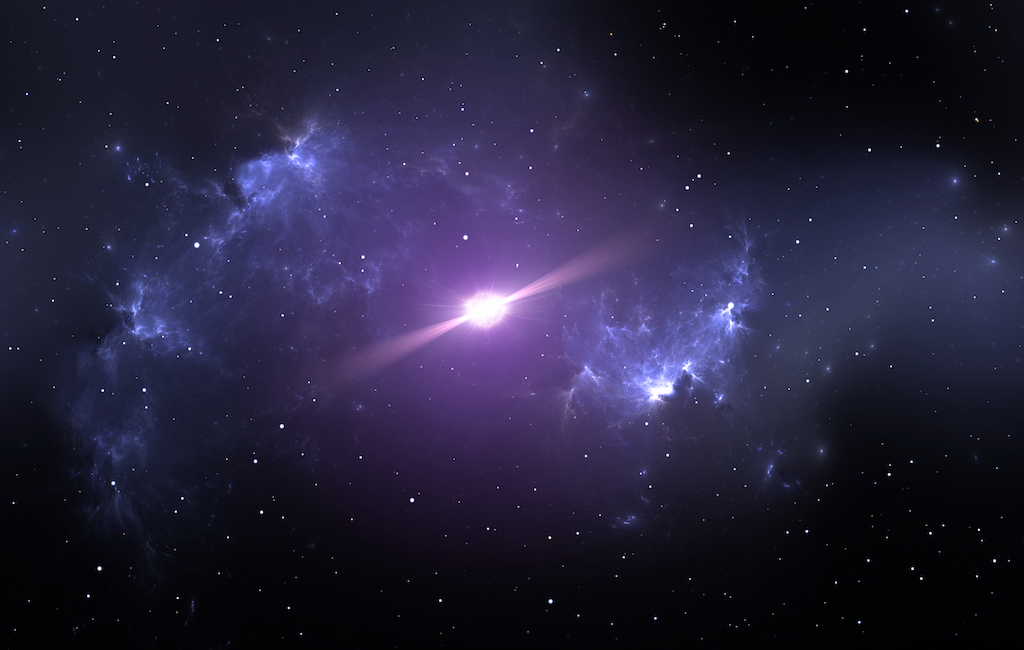1st measurement of a neutron 'skin' is unlocking the secrets of exploded stars
The neutron skin is what keeps neutron stars from imploding into black holes.

Physicists have measured the microscopically thin skin of neutrons enclosing the insides of atoms of lead for the first time, finding that it's thicker than expected. The discovery could help to unravel some of the mysteries of neutron stars — ultradense stellar corpses that are chock full of neutrons.
An atom's skin is an odd thing to imagine. The popular image of the atomic nucleus tends to depict protons and neutrons being packed together randomly inside a sphere — like gumballs in an old-fashioned glass dispenser. But in reality, heavier elements tend to distribute their building blocks more unevenly, with some neutrons nudged outward to form a thin "skin" that encloses the core of mixed neutrons and protons.
Related: 8 ways you can see Einstein's Theory of Relativity in real life
"The protons in a lead nucleus are in a sphere, and we have found that the neutrons are in a larger sphere around them, and we call that the neutron skin," study co-author Kent Paschke, a professor of experimental nuclear and particle physics at the University of Virginia, said in a statement.
Because the skin is created by the sheer density of inner protons and neutrons pressing out on the remaining neutrons, a measurement of the neutron skin is a handy way of measuring the density of the entire nucleus. To do this, the researchers set about measuring the difference in size between the "inner" and "outer" spheres of lead-208 — an isotope of lead with 126 neutrons and 82 protons.
Finding the size of the inner sphere was fairly easy, and had been done before. Paschke and his team fired electrically charged particles at the positively charged protons in the center of the atom, and then measured how the charged particles bounced off the protons. The neutrons of the outer sphere, however, have no charge. This means that a different method was needed to measure their density — one using the angular momentum of scattered electrons.
By firing a precisely controlled beam of electrons into a thin sheet of the lead isotope, cooled to cryogenic temperatures to make the nuclei a stationary target, the researchers measured the distinct way that electrons with specific angular momentums were deflected after interacting with the neutrons. Because the electrons were deflected more often in one direction when they had a certain angular momentum, the researchers could use the deflected electrons to create a picture of the thickness of the neutron skin. They found that it is about 0.28 trillionths of a millimeter thick, ten billion times thinner than a red blood cell. This is slightly thicker than physicists first thought it would be.
Sign up for the Live Science daily newsletter now
Get the world’s most fascinating discoveries delivered straight to your inbox.
"This is the most direct observation of the neutron skin. We are finding what we call a stiff equation of state — higher than expected pressure so that it's difficult to squeeze these neutrons into the nucleus," Paschke said. The equation of state is the equation that describes the state of matter under a given set of conditions. "And so, we're finding that the density inside the nucleus is a little bit lower than was expected."
Knowing the thickness of this skin isn't just vital for understanding the properties of atoms, but also for understanding neutron stars — the ultradense remnants of massive stars formed after enormous stellar explosions, or supernovas. As neutron stars are made up of 90% neutrons, understanding how neutrons structure themselves inside atoms will also shed light on the limits they place on the size of these mysterious stellar remnants — and how the neutron skin seems to stop gravity from squishing them until they become black holes.
As lead is one of the densest materials found on Earth, the density of their neutron skin makes for an excellent point of comparison to the incredibly dense neutron star. A second team of researchers, working off the back of the first team's study in lead, were able to update previous estimates of a neutron star's radius from a maximum of 7.5 miles (12 kilometers) to a maximum of 8.9 miles (14.25 km).
"There is no experiment that we can carry out in the laboratory that can probe the structure of the neutron star," Jorge Piekarewicz, co-author of the second study and a physicist at Florida State University, said in a statement. "A neutron star is such an exotic object that we have not been able to recreate it in the lab. So, anything that can be done in the lab to constrain or inform us about the properties of a neutron star is very helpful."
Despite the preliminary nature of these results, Piekarewicz was positive that they would be used alongside future results to further unlock the mysterious nature of neutron stars.
"It's pushing the frontiers of knowledge," Piekarewicz said. "We all want to know where we've come from, what the universe is made of and what's the ultimate fate of the universe."
The first and second teams both published their findings April 27 in the journal Physical Review Letters.
Originally published on Live Science

Ben Turner is a U.K. based staff writer at Live Science. He covers physics and astronomy, among other topics like tech and climate change. He graduated from University College London with a degree in particle physics before training as a journalist. When he's not writing, Ben enjoys reading literature, playing the guitar and embarrassing himself with chess.










